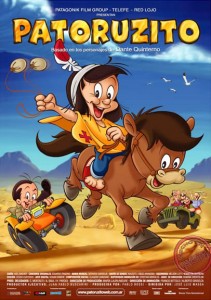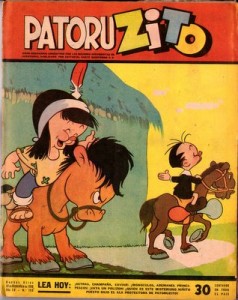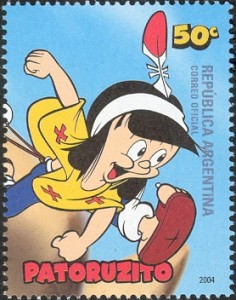Part six of my survey of Argentine animated feature films – today with films from José Luis Massa and Sergio Bayo.
 Patoruzito, directed by José Luis Massa. 75 minutes. July 8, 2004.
Patoruzito, directed by José Luis Massa. 75 minutes. July 8, 2004.
A lot of background is needed here. The Tehuelche natives of Patagonia were discovered by 16th-century Spanish explorers, but they lived far enough south that the Spanish considered their lands too cold and rocky and never settled them. Their tallness and super-hardiness – they lived almost naked in what the Spanish deemed a freezing climate – grew legendarily into the Tehuelches becoming super-strong giants with huge feet, but very primitive and peaceful. They were not “civilized” until Argentina became independent and began expanding into its south in the 19th & 20th centuries; and some of them became gauchos.
Cartoonist Dante Quinterno (1909-2003) created the character Patoruzú in 1928 as the last cacique of the Tehuelches before they became integrated into Argentine civilization. His comics were funny adventures like E. C. Segar’s Thimble Theater in the U.S. He played up the legendary aspects of the Tehuelches; they were tall and super-strong, and Patoruzú was the strongest and wealthiest of them; but he was very naïve and constantly being tricked by sophisticated villains from Buenos Aires taking advantage of him. During the 1930s Quinterno built up a large supporting cast; his Patoruzú comic magazine was started in 1936 and became more popular with adults than children throughout Argentina and Uruguay. In 1942 he made the Upa en Apuros animated short.
 In 1945 he started a Patoruzito magazine for children, about the adventures of his characters when they were children. The boy Patoruzito, about 8-10 years old, became more popular than the adult Patoruzú. By the late 1990s-early 2000s, Quinterno had retired but was merchandising his cartoon characters everywhere; there was a set of Argentine 2004 postage stamps of Patoruzito, his horse Pamperito, his girlfriend Malén, his pal Isidorito, etc.; and the Patagonik Film Group licensed them for theatrical animated features. Patagonik’s Juan Pablo Buscarini was Executive Producer.
In 1945 he started a Patoruzito magazine for children, about the adventures of his characters when they were children. The boy Patoruzito, about 8-10 years old, became more popular than the adult Patoruzú. By the late 1990s-early 2000s, Quinterno had retired but was merchandising his cartoon characters everywhere; there was a set of Argentine 2004 postage stamps of Patoruzito, his horse Pamperito, his girlfriend Malén, his pal Isidorito, etc.; and the Patagonik Film Group licensed them for theatrical animated features. Patagonik’s Juan Pablo Buscarini was Executive Producer.
The Argentine animation industry had learned to produce a smooth blend of cartoon and CGI animation by 2004. Despite the fact that the adult Patoruzú became popular in the 1930s, and Patoruzito (introduced in 1945) was supposed to be Patoruzú as a child, the 2004 Patoruzito movie is set in the present.
In a prologue under the opening credits, Egypt in 2200 B.C. is a powerful nation under the Patoruzek dynasty, but the evil Arotep steals an amulet of magic power from the last Patoruzek pharaoh. They battle, and the amulet is split in two. The last pharaoh, recognizing that he has lost, sails from Egypt with the last of the Patoruzeks to find a new homeland – Patagonia. The movie jumps to the present; 2004 A.D. The Tehuelches are roughly divided into two groups; those who live on the pampas like their ancestors, and those who live on estancias (large ranches) like gauchos. Patoruzito is the young heir (about 8 or 10 years old) of the last cacique’s estancia. He lives there with his family while the estancia is run by La Chacha, his pipe-smoking nanny who makes delicious empanadas and soup, and the strict but loyal foreman, Ñancul. A frequent visitor and playmate is Isidorito Cañones, the snooty but friendly child nephew of Colonel Cañones, the super-rich financial manager of Patoruzito’s fortune in Buenos Aires.
 Three young Tehuelche delinquents, Cobul, Cachicó, and Tico, start a fire on the estancia to steal horses. Ñancul and Patoruzito arrive in a jeep to save the remaining horses from the fire, including the young foal Pamperito. This is when Patoruzito and Pamperito first meet.
Three young Tehuelche delinquents, Cobul, Cachicó, and Tico, start a fire on the estancia to steal horses. Ñancul and Patoruzito arrive in a jeep to save the remaining horses from the fire, including the young foal Pamperito. This is when Patoruzito and Pamperito first meet.
Col. Cañones hosts a big birthday party for Patoruzito, marking him to have reached the age to become the new cacique of the Tehuelches. Cobul, Cachicó, and Tico oppose this. Among the celebrants is Prof. Ferguson, an archaeologist who is researching the history of the Tehuelches. The viewer sees that Ferguson is a modern double of Arotep with half of the amulet. A band of “wild” Tehuelches arrives. Their leader says that they recognize Patoruzito as the son of their last cacique, but before they can recognize him as their new cacique, he must enter the Lost Valley and obtain the three signs of skill, courage, the Tehuelche spirit, and their freedom: the Blue Stone from an active volcano; an amulet from the Hidden Cave where their ancestral caciques are buried; and a condor’s feather. Patoruzito accepts the test, while Ferguson offers to Cobul, Cachicó, and Tico to make sure that they win.
Patoruzito, in his native costume, with Pamperito, and Isidorito in a modern explorer’s costume, set out, with Ferguson and the three delinquents trying to sabotage them. Patoruzito and Isidorito get the Blue Stone. On their way to the second test, Patoruzito rescues Malén, a young Tehuelche girl, from hungry pumas. This is how Patoruzito and Malén meet. She introduces them to old Egolia, her grandfather and the ancient guardian of the Hidden Cave, who trains Patoruzito for the cave’s dangers. The viewer sees that the tombs of the former caciques go back to ancient Egyptian styles. Ferguson and his three activate ancient Egyptian deathtraps against Patoruzito, but he uses Egolia’s training to escape.
Patoruzito has to climb Andean peaks to get a condor’s feather, with Ferguson and the others cutting the rope bridges that he is on. He succeeds, and brings the three treasures to the hidden Tehuelche center in the Lost Valley. But Ferguson and the three renegade Tehuelche youths follow him there. Ferguson reveals that his goal all along was to find the center and the missing half of the magic amulet, and he turns on his allies. Ferguson unleashes the Egyptian magic to conquer everything, but Patoruzito, with the help of the other Tehuelches (including the three now-reformed delinquents), defeat him. Patoruzito and Isidorito return to the estancia to begin their growth to adulthood.
Patoruzito was a huge success. It was shown in every theater in Argentina and Uruguay, selling 2,500,000 seats. It was shown in several other Latin American and European countries. It won the Silver Condor Award in 2005.
Teo, Cazador Intergaláctico (Teo, Intergalactic Hunter), directed by Sergio Bayo. 80 minutes. December 9, 2004.
 Another smooth blend of cartoon and CGI animation; an Argentine-Spanish co-production that was released first in Argentina, by Columbia Tristar. Teo, a green reptilian spaceman, is the young (some reviews say only 12 years old, which is probably the recommended age group of the audience) grandson of Emperor Oldux of the planet Sauracia. He is supposed to be in training to become the next emperor, but he prefers to be an intergalactic hunter with his robot partner Oki, shrinking giant beasts to handheld size for Sauracia’s zoos. Royal counselor Intrígalus, who plots to become Oldux’s successor, encourages Teo to go to newly-discovered, far-off Earth to capture the dangerous animals there (making sure that Teo never returns).
Another smooth blend of cartoon and CGI animation; an Argentine-Spanish co-production that was released first in Argentina, by Columbia Tristar. Teo, a green reptilian spaceman, is the young (some reviews say only 12 years old, which is probably the recommended age group of the audience) grandson of Emperor Oldux of the planet Sauracia. He is supposed to be in training to become the next emperor, but he prefers to be an intergalactic hunter with his robot partner Oki, shrinking giant beasts to handheld size for Sauracia’s zoos. Royal counselor Intrígalus, who plots to become Oldux’s successor, encourages Teo to go to newly-discovered, far-off Earth to capture the dangerous animals there (making sure that Teo never returns).
Thanks to Intrígalus’ sabotage, Teo is captured on Earth by Rata and Oso (Rat and Bear), two sleazy comedy-relief dogcatchers who mistake Teo for a weird dog. If their caged animals aren’t bought in a short time, they slaughter them for sausages and dogfood. Oki finds two human children, Lucas and his little sister Popi, to rescue Teo; but before they can, Teo is sold to Siniestri, a ruthless big-game hunter who has mounted-head trophies of everything except an alien. Many reviews end with “Teo goes in an instant from intergalactic hunter to intergalactic prey”.
Teo, Cazador Intergaláctico was produced by a consortium of studios including Argentina’s semi-governmental Instituto Nacional de Cine y Artes Audiovisuales (INCAA) and Argentina’s Shazam Producciones, S.A. studio, though the first-listed animation studio is Spain’s Alma Ata International Pictures, S.L. Popi looks suspiciously like a redheaded Angelica Pickles from Nickelodeon’s Rugrats.
Next week: Argentine Animated Features: Three 2006 Movies


 Fred Patten (1940-2018) was an internationally respected comics and animation historian. He has written about anime or comic books for publications ranging from Animation Magazine and Alter Ego to Starlog. He was a contributor to The Animated Movie Guide (2005), and is author of Watching Anime, Reading Manga (2004, Stone Bridge Press), a collection of his best essays, and Funny Animals and More (2014, Theme Park Press), based upon his early columns here on Cartoon Research. He passed away on November 12th, 2018.
Fred Patten (1940-2018) was an internationally respected comics and animation historian. He has written about anime or comic books for publications ranging from Animation Magazine and Alter Ego to Starlog. He was a contributor to The Animated Movie Guide (2005), and is author of Watching Anime, Reading Manga (2004, Stone Bridge Press), a collection of his best essays, and Funny Animals and More (2014, Theme Park Press), based upon his early columns here on Cartoon Research. He passed away on November 12th, 2018.





































The semi-governmental Instituto Nacional de Cine y Artes Audiovisuales (INCAA), is not semi-governmental at all… it is the Federal Government financing all of the movies, always in a questionable fashion. Production companies actually never spend any money in their own movies… they all list them as flops, even when they are a success, so they never have to give back the subsidy.
When PATORUZITO was released, I already had moved into the United States and my frustration was that I was not able to see it. However, at the time, our own Jerry Beck found the trailer and stated “it looks like a Tito and Burrito cartoon!”. The distribution rights for the film, as it can be seen in the poster itself, are Disney’s and I never understand why it was never exhibited in the United States. Disney at the time was having a bad year with losses and it was incomprehensible to me why they get these films so they are never shown… We can say that they show a number of Argentine traditions, which is true. But how many time we have seen from Hollywood US traditions that are imported to countries in which they can never impose them. Fortunately I managed to get access to a copy of the films a couple of months later. The fact that it is available for free now, like other films it is an indication that nobody cares for it because it seems that it no longer makes any money.
PATORUZITO is a nice, pleasant and intelligent film whose only flaw is the CGI animation which does not blend well at all with the rest. It is not different than the cartoon strips I used to read a child. Dante Quinterno always updated his drawings to the contemporary times in which they were reprinted., but the design of Isidorito Cañones (and eventually Isidoro Cañones too) was stuck in the forties. It is interesting to see how the stories changed through the years, generally with minor changes. Although PATORUZITO was more intended for children than general audiences, the stories are not different than the ones featuring PATORUZU. The adult version, however, is the funnier by far because the characters far more flexibility. Unlike what you explained, PATORUZU in adult form is still the most popular character.
It is odd when a Hollywood distributor in another country would do that. Often it’s only for that particular market and nowhere else. I recall something similar to that happens in Europe or Japan where a particular film is said to be released through companies like Warner Bros. or Disney, but never in the US through them.
What’s interesting is Patoruzito (Little Patoruzo) was so popular is that they even produced a animated short entitled “Vamos a la Camita al Dorimir” ( Let’s go to the little Bed to sleep) in which Potoruzito,Isadoro and Pamperito get ready to go to sleep. It aired on Argentine television at around 7:55 pm when it was bedtime for the children and the “mature/adult” programs were going to be broadcasted. Reminded of another popular Argentine cartoon character named “El Mono Relojero” (The Monkey Clocksmith) which was animated by Billiken Animation Productions who also had a “bedtime animated short” for the children which aired on The Spanish International Network (SIN now Univision) in the 1980’s.
The Patoruzito short “vamos a la camita a dormir” aired at 10 PM, I think in 1987. The one featuring “El Mono Relojero” was from around 1972. García Ferré made one with Anteojito in 1991.
The use of “Time For Bed” films seem to be a thing I noticed with some countries like Argentina that never really happened in the US at all. It would’ve been kinda neat had one of the Big Three instituted such a film to be played at certain time of their schedule to remind parents when to do so (of course parents should know better already I suppose). Along with SIN, a station serving the NYC area carried the “Mac Perro” film as well (WNJU 41).
I got to see the feature at an Argentine film festival at the Egyptian theater around the time it was released in Argentina. I took my dad with me to that screening, afterwards we stopped to speak with the creators of the film. I enjoyed it…but prefer the adult version of the character. I love the Isidoroas an adult, he’s like Wimpy in Popeye, but instead of an addiction to hamburgers, he wants booze and women.
I learned to read Spanish or Castellano as they say in Argentina by reading Patoruzu, Patoruzito and Hijitus.
Thanks again for the trip down memory lane.
why does their animation look like Tiny Toon Adventures? and even specifically the TMS Entertainment studio’s out put. are they using a similar animation overseas staff? did they watch “How I spent my summer vacation “? Not that its a bad influence at all. just wanted to pose this question and see if others have made the same comparison .
I should have specified I’m talking about Patoruzito